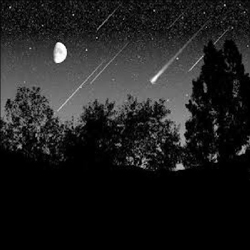The Meteor Shower Radiant Calculator is a Java Script program that computes the location of the radiant of a meteor shower using two meteor trails. The calculator requires the beginning and ending celestial coordinates for two meteors as input data.
The average of many locations from several pairs of meteor trails should provide a good estimate of the true location of the radiant. Since its location drifts slowly, the meteors used in computation of a point should have occurred close together in time.
To operate the calculator, first enter the starting and ending coordinates for two meteor trails. Then, press the Calculate button. On invalid entries, the output windows will display: NaN -- Not a Number.
Use the 'Test' button to see how the calculator works.
Notes
What is the radiant of a meteor shower?
Small bits of rock escape from comets when they are warmed by the Sun. This debris spreads out but tends to remain in the comets orbit. Meteor showers occur when the Earth crosses the orbit of a comet in the path of the comet debris. During a meteor shower, the meteors appear to come from a point in the sky called the radiant. This effect is an optical illusion.
The comet debris that produces the shower is moving in parallel trajectories; because parallel lines appear to meet at infinity, the meteors seem to radiate from a point. For well-known meteor showers, the coordinates for the radiant position are usually given at the peak of the shower. However, a radiant position will drift slowly across the sky due to the Earth's orbital motion around the Sun.
Computing the radiant of a meteor shower
As seen from a point on the Earth's surface, meteor trails will appear to be following great circle paths. The great circles for meteors of a shower have two common intersection points; the radiant above the horizon and the anti-radiant below. The geometric definition of a great circle is the intersection of the sphere and a plane that passes through the center of the sphere. We can make use of this fact together with observation of the right ascension and declination of the beginning and ending points of meteor trails to compute the location of a radiant from two trails.
Three points can define a plane. The beginning and ending points of a meteor trail and the center of the Earth define a plane that passes through the celestial sphere that gives us the great circle for the meteor trail. A second set of three points defines another plane for the great circle of a second meteor trail. The intersection of the two planes is a straight line. The radiant and anti-radiant are on this line.


